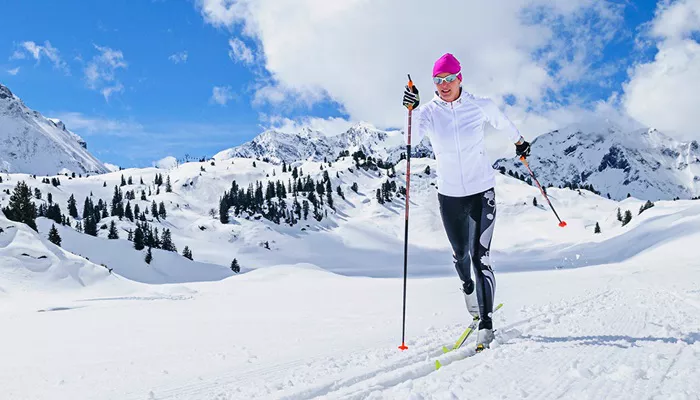Cross-country skiing is a dynamic and rewarding winter sport that provides an excellent full-body workout while allowing enthusiasts to explore beautiful snowy landscapes. Within cross-country skiing, there are two primary techniques: skate skiing and classic skiing. While both disciplines share fundamental similarities, such as requiring similar equipment and being performed on snow-covered trails, they differ significantly in terms of technique, equipment, terrain, and overall experience.
For those new to the sport or looking to switch styles, understanding the differences between skate and classic cross-country skiing is crucial for selecting the right technique. This article will explore the distinctions between the two styles, comparing aspects such as movement mechanics, required equipment, ideal conditions, and skill levels.
Technique Differences Between Skate and Classic Skiing
The most apparent difference between skate and classic skiing lies in the movement techniques used to propel the skier forward.
Skate Skiing Technique
Skate skiing closely resembles ice skating or rollerblading.
Skiers push off the edges of their skis in a V-shape motion, alternating their weight from one ski to the other.
Requires an active use of upper and lower body coordination to maintain speed and efficiency.
Generally faster than classic skiing, making it popular for racing and competitive events.
Demands well-groomed, firm trails with wide lanes to accommodate the skating motion.
Classic Skiing Technique
Classic skiing mimics a natural walking or running motion, moving skis in parallel tracks.
Utilizes a diagonal stride where one ski glides forward while the opposite arm pushes with a pole.
Skis remain parallel, requiring a kick-and-glide motion for propulsion.
Can be performed on groomed tracks or in untouched snow, offering more versatility.
Often considered easier for beginners since the technique feels more intuitive.
Equipment Variations
Although both techniques use similar gear, there are significant differences in ski design, poles, and boots that cater to the unique movement styles of skate and classic skiing.
Skis
Skate Skis: Shorter, stiffer, and designed for edge-to-edge push-off.
Classic Skis: Longer and more flexible to enable smooth gliding with grip zones underfoot.
Ski Bindings
Skate Bindings: Provide strong lateral support for increased stability when pushing off.
Classic Bindings: Allow for more vertical flexibility to facilitate the kick-and-glide technique.
Ski Poles
Skate Poles: Longer poles (typically reaching the skier’s chin or nose) to assist with powerful poling motions.
Classic Poles: Shorter poles (reaching shoulder height) designed for efficient diagonal striding.
Boots
Skate Boots: Stiffer ankle support with rigid soles to enhance lateral stability and power transfer.
Classic Boots: More flexible soles for natural foot movement and a softer upper to allow ankle mobility.
Terrain And Trail Conditions
The type of terrain and trail grooming can influence whether skate or classic skiing is more suitable.
Skate Skiing Terrain
Requires well-groomed trails with packed, firm snow.
Performed in dedicated skate lanes, often found alongside classic tracks.
Not ideal for deep, powdery snow or ungroomed trails.
Classic Skiing Terrain
Can be done on groomed tracks, backcountry trails, or even in fresh snowfall.
More versatile in varying snow conditions.
Allows access to remote and scenic trails that may not be suitable for skate skiing.
Speed, Endurance, and Physical Demand
Both styles of cross-country skiing offer excellent cardiovascular exercise, but they differ in speed and intensity levels.
Skate Skiing Performance
Faster due to the skating motion, similar to ice speed skating.
Requires more energy and engages more muscle groups simultaneously.
Best suited for athletes looking for high-intensity workouts or competitive racing.
Classic Skiing Performance
Generally slower but more sustainable over long distances.
Less physically demanding than skate skiing, making it ideal for endurance-focused skiers.
Provides a relaxing yet effective way to enjoy the winter landscape.
Learning Curve and Skill Development
When choosing between skate and classic skiing, it’s essential to consider the learning curve associated with each technique.
Skate Skiing Difficulty
More challenging for beginners due to the need for balance and coordination.
Requires practice to master weight shifting, edge control, and efficient poling.
Better suited for skiers with prior experience in ice skating or rollerblading.
Classic Skiing Difficulty
Easier for beginners due to its natural walking-like motion.
More forgiving in terms of balance and technique.
A great starting point for those new to cross-country skiing before transitioning to skate skiing.
Which Style Is Right for You?
The decision between skate and classic skiing depends on personal preferences, fitness level, and skiing goals.
Choose Skate Skiing If:
You enjoy a fast-paced, high-intensity workout.
You have experience with skating, rollerblading, or similar sports.
You have access to well-groomed skate trails.
You are interested in racing or competitive skiing.
Choose Classic Skiing If:
You prefer a more relaxed and natural movement style.
You want to ski in a variety of conditions, including backcountry trails.
You are new to cross-country skiing and want an easier learning curve.
You enjoy long-distance endurance skiing with a steady pace.
Conclusion
Both skate and classic cross-country skiing have unique benefits and challenges, making them suited for different types of skiers. Skate skiing offers a fast, dynamic, and physically demanding experience best suited for groomed trails and competitive athletes. Classic skiing, on the other hand, provides a more accessible and versatile option, allowing skiers to enjoy both groomed tracks and natural snow conditions at a more relaxed pace.

